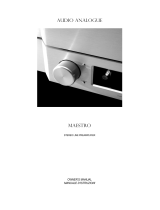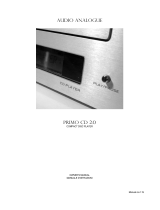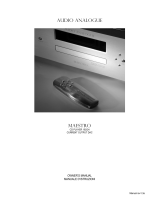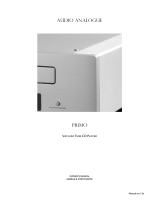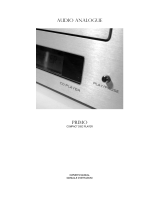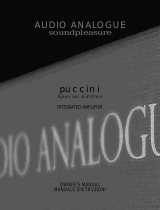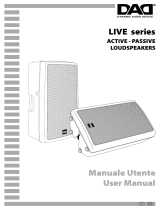Page is loading ...

2
INTRODUCTION
AUDIO ANALOGUE does not take any responsibilities in the following cases:
Whenever the operational procedures related to the use and the maintenance of the equipment, as described in this manual, are not
respected.
Whenever damages to the equipment occur because of fixing or modifications made from non-authorized staff or because of normal
deterioration of the system.
No part of this manual can be reproduced by any means, transmitted or copied for private or public use without private authorization
from AUDIO ANALOGUE.
The information contained in this manual is related to the data kept by AUDIO ANALOGUE at the moment of the issue of this
publication; AUDIO ANALOGUE has the right to make changes to this document without notice.
The equipment has been designed and manufactured according to the Regulations of the Community 89/336/CEE and is marked CE.
This equipment can’t be used for different purposes other than those for which it has been manufactured.
AUDIO ANALOGUE does not take any responsibilities for accidents or damages due to improper use of the equipment.
WARNING
Please do respect the safety standards contained in this manual before starting to operate the equipment.
Do not open the equipment. No further interventions than those described in this manual should be made. For technical assistance,
please contact a qualified technician or an AUDIO ANALOGUE dealer.
Not respecting the instructions contained in this manual will invalidate the guarantee terms and conditions.
NECESSARY PRECAUTIONS FOR SAFETY AND MAINTENANCE
ATTENTION: Read the following instructions and precaution carefully and completely before.operating or manteining your Audio
Analogue MAESTRO DUECENTO integrated amplifier.
It’s mandatory to comply with the following regulations to avoid any hazard:
Always disconnect your entire system from AC mains before connecting or disconnecting any cables.
The labels containing information about safety must be always visible and in good conditions.
Never block air flow through ventilation slots or heatsink to avoid excessive overheating.
The equipment should be kept to a minimal distance of 15 cm from any object and should not be placed on carpet or other soft
surfaces.
Do not switch on the equipment until it has not been correctly and completely installed.
Always supply the equipment with the proper voltage as stated on the rear label. If in doubts about the available supply, please
contact a qualified technician or an AUDIO ANALOGUE dealer.
This equipment must be terminated with a three-conductor AC mains power cord which includes an earth ground connection. To
prevent shock hazard, all three connections must always be used.
In case of damages occurred to the supply cable, it should be immediately replaced with an other of the same kind.
Do not place any objects over the supply cable. The cable shouldn’t be knotted, pinched or abruptly bended.
Replace the fuses always with others of the same kind.
Do not use the equipment close to water or other liquids. If any liquid fill in the equipment, the mains plug must be disconnected from
the socket avoiding to touch any metal parts. The equipment must be checked by qualified technician before being operated again.
Do not place recipients containing liquids on the equipment, even if it is switched off.
Keep the equipment far away from sources of heat such as the solar light, ovens, radiators etc…
Always unplug the supply cable during lightning storms.
Always switch off and unplug the mains cable before cleaning the equipment externally: this operation should be made only using a
dry and soft cloth. Never use alcohol based cleaning material.
Internal condesation can be formed if the amplifier is carried from an extremely cold environment to an extremely hot one. Please wait
at least for an hour before operating it again.
Please unplug the equipment if not used for long periods.
INSTRUCTIONS TO PUT IT OUT OF SERVICE
Consult qualified staff.
Follow the regulations of the current legislation regarding recycling and waste disposal.

5
Front panel
1. SELECT Inputs selector. It allows selecting the desired source. The selected input is shown in the central display.
2. VOLUME Volume control. Rotate it clockwise to increase the volume; counterclockwise to decrease it. The volume level is
shown in the central display. The maximum level is 48.
3. STAND-BY BUTTON It’s located under the front panel. Pushed for 3 seconds turns on the amplifier. Pushed again shut it
off immediately.
4. IR RECEIVER It’s located into the central display.
Pannello frontale
1. SELECT Selettore degli ingressi. Consente di selezionare la sorgente desiderata che viene mostrata sul display centrale.
2. VOLUME Controllo di volume. Ruotando in senso orario il volume aumenta, viceversa diminuisce. Il livello del volume è
mostrato sul display centrale. Il massimo volume si ha con livello 48.
3. STAND-BY BUTTON E’ posizionato sotto lo chassis frontale. L’amplificatore si accende tenendolo premuto per circa 3
secondi. Premendolo nuovamente l’amplificatore si spegne.
4. IR RECEIVER E’ posto all’interno del display centrale.
1 24
3

6
Back panel
• RIGHT SPEAKER OUT: Right speaker out connector.
• LEFT SPEAKER OUT: Left speaker out connector.
• TAPE OUT: Tape output.
• INPUT 1,2,3,4,5: Unbalanced line inputs.
• BALANCED INPUT 6: Balanced line input.
• AC MAINS: Connect here the provided power cord.
• FUSE: If necessary, replace it with an other of the same kind (see back panel label).
• POWER: Main switch.
Descrizione del pannello posteriore
• RIGHT SPEAKER OUT: Connettore per collegamento uscita di potenza destra.
• LEFT SPEAKER OUT: Connettore per collegamento uscita di potenza sinistra.
• TAPE OUT: Uscita per registratore.
• INPUT 1,2,3,4,5: Ingressi sbilanciati.
• BALANCED INPUT 6: Ingresso bilanciato.
• AC MAINS: Collegare qui il cavo di alimentazione fornito in dotazione.
• FUSE: Se necessario sostituire con un altro dello stesso tipo (vedi l’etichetta sul pannello posteriore).
• POWER: Interruttore principale

7
Remote control
• STBY. Standby. Activates/deactivates standby mode.
• VOL+/VOL-. Volume setting.
• MUTE. Activates/deactivates muting. When muting is activated, volume level is reduced to zero level. When deactivated the volume level
is increased, in some seconds, to the level set before the muting
• IN+/IN-. Allows source selection and navigation through the set-up.
• SET. This button activates the set-up.
Descrizione del telecomando
• STB. Stand-by. Attiva e disattiva lo stato di stand-by.
• VOL+/VOL-. Regolazione del volume.
• MUTE. Attiva e disattiva lo stato di muting. Quando lo stato di muting è attivo il volume di ascolto viene ridotto a zero. Quando viene
riattivato il volume torna al valore impostato precedentemente in qualche secondo.
• IN+/IN-. Seleziona la sorgente per l’ascolto e permette la navigazione nel set-up
• SET. Richiama il menu di set-up.
Unpacking and checking MAESTRO DUECENTO package
Carefully open the package to avoid damaging the content. The package should contain:
• 1 MAESTRO DUECENTO integrated amplifier.
• 1 remote control.
• 1 power cord.
• 2 AAA batteries (already placed in the remote control).
• 1 instruction manual.
If one of the items listed above is missing, please contact your Audio Analogue retailer. After extracting the smallest items from the package, pull out
the unit carefully. Separate the package from the anti-shock expanded-foam protections.
Apertura e ispezione dell’imballo
Aprire la scatola con cautela per non danneggiare il contenuto. L’imballo deve contenere:
• 1 Classe A
• 1 telecomando
• 2 batterie AAA (già contenute nel telecomando)
• 1 cavo di alimentazione
• 1 manuale di istruzioni
Se qualcuno degli oggetti sopra elencati dovesse mancare, contattate il Vostro rivenditore Audio Analogue di fiducia.
Dopo avere estratto le parti di minori dimensioni, estrarre con cautela l’apparecchio dall’imballo. Separare l’imballo dalle imbottiture antiurto in
schiuma espansa.

8
Where to place the MAESTRO DUECENTO integrated amplifier
MAESTRO DUECENTO is a high power unit. After some hours of high volume operation the unit temperature can raise up to 45-50°C, be carefull!
Please locate the unit in a well-ventilated place. In particular, you should leave at least 5 cm around and above the unit and avoid placing it close to
heat sources (radiators, heaters, amplifiers, television sets).
Scelta del luogo in cui posizionare l’integrato MAESTRO DUECENTO
L’integrato MAESTRO DUECENTO è un apparecchio ad alta potenza e quindi può scaldare molto. Dopo qualche ora di funzionamento ad alto
volume la sua temperatura può raggiungere i 45-50°C, fate attenzione!. Per questo motivo è consigliabile posizionarlo laddove sia garantita una
corretta circolazione d’aria. In particolare, è opportuno garantire uno spazio sufficiente attorno e sopra l’apparecchio (almeno 5 cm), ed evitare
posizionamenti vicino a fonti di calore (termosifoni o stufe, lampade alogene,, televisori).
Plugging and connecting
Before connecting the MAESTRO DUECENTO integrated amplifier to the sources, please be sure that they’re all unplugged from wall outlets. First
of all, connect the sources to the MAESTRO DUECENTO inputs you want to use. Please use only high-quality cables with gold-plated connectors.
As the second step, connect MAESTRO DUECENTO outputs to the speakers’ cable.
At last, plug the power cord into the MAESTRO DUECENTO inlet and into the wall outlet.
WARNING! MAESTRO DUECENTO HAS a power switch in the rear panel. To put the amplifier in stand-by you MUST place the rear panel switch in
position 1.
Collegamento dell’integrato
Prima di collegare il MAESTRO DUECENTO alle sorgenti audio, verificare che tutti gli apparecchi siano scollegati dalla rete elettrica.
Per prima cosa, collegare le sorgenti audio agli ingressi del MAESTRO DUECENTO che si desiderano utilizzare. Utilizzare solo cavi della migliore
qualità, terminati con connettori dorati.
Quindi, collegare le uscite del MAESTRO DUECENTO ai diffusori.
Infine, collegare il cavo di alimentazione fornito in dotazione al MAESTRO DUECENTO all’apposita vaschetta. La spina del cavo di alimentazione
andrà poi collegata ad una presa di rete.
ATTENZIONE! Il MAESTRO DUECENTO E’ dotato di interruttore di rete, per metterlo in stand-by è necessario spostare tale interruttore, posto sul
pannello posteriore, in posizione 1.
Powering up MAESTRO DUECENTO
When you set the rear switch of MAESTRO DUECENTO in the position “1”, the unit turns on in the STANDBY mode. When the front button is kept
pressed for at least three seconds or when the “STBY” button on the remote control is pressed, the amplifier turns on. The amplifier will powers up
about in ten seconds. During power up the protection circuit check the status of the power lines and the absence of a DC voltage on the speaker
outputs; the central display indicate “POWERING …”. You’ll hear some “click” inside the amplifier, this is absolutely normal! If nothing happens or if
an error message is displayed, please refer to the troubleshooting section of the present manual. Even if it is safe to turn the unit off unplugging it
from the outlet when unused for long periods of time or during lightning storms, it is possible to leave it plugged when using it daily. To this purpose,
please put the unit in the Stand-by mode (don’t use the rear switch). The amplifier is internally disconnected from the mains.
Accensione del MAESTRO DUECENTO
Porre nella posizione “1” il pulsante posteriore determina la condizione Stand-by dell’amplificatore. Per accendere l’apparecchio occorre tenere
premuto per almeno tre secondi il pulsante situato sotto il pannello frontale oppure premere il tasto “STBY” del telecomando. L’unità impiega circa
dieci secondi per accendersi. Durante la fase di accensione il circuito di protezione verifica lo stato di tutte le alimentazioni e l’assenza di tensione
continua sulle casse. Il display centrale indica “POWERING…”. Si sentono degli scatti provenire dall’interno dell’amplificatore, ciò è assolutamente
normale! Se invece non succede niente oppure viene scritto un messaggio di errore fare riferimento alla sezione di risoluzione dei problemi di questo
manuale. Durante i temporali con fulmini o i lunghi periodi di inattività è consigliabile spegnere l’apparecchio e staccarlo dalla presa a muro. Durante
i periodi di uso normale è consigliabile spegnere l’apparecchio tenendolo in stand-by (senza usare l’interruttore posteriore). L’amplificatore è
comunque sconnesso internamente dalla rete elettrica.
Volume settings and silencing (mute)
The volume control on the front panel and the Vol+/Vol- buttons on the remote control change the general sound level. It means that the volume of
the two channels is changed identically. It is possible to modify the relative level of each channel changing the balance option in the remote control
setup. The mute buttons on the remote control allows lowering the sound level to 0. This function is useful any time you have to suddenly lower the
volume, for example when you answer to a phone call or when talking with people or when changing CD in the player. When the unit is muted, the
status is displayed in the central display. Mute deactivating will restore slowly the previous volume setting.
Regolazione del volume e silenziamento (mute)
La manopola del volume sul pannello frontale e i pulsanti Vol+/Vol- sul telecomando agiscono sul livello generale di ascolto. Ciò significa che il
volume di entrambi i canali viene modificato dello stesso valore. E’ possibile eseguire un bilanciamento dei canali usando l’opzione “balance” nel
menù di set-up del telecomando.
Il pulsante di mute sul telecomando permette di attenuare istantaneamente il livello di ascolto al valore 0. Questa funzione è utile qualora sia
improvvisamente necessario abbassare il volume di ascolto, per esempio per rispondere al telefono o per parlare con qualcuno o ancora quando si
desidera cambiare il CD nel lettore. Lo stato di muting dell’apparecchio viene indicato sul display centrale. La disattivazione del mute ripristinerà
lentamente il precedente livello di ascolto.

9
Inputs selection
You may select your desired audio input by turning the “SELECT” knob on the front panel or the “IN+/IN-“ buttons on the remote control. The volume
will be reset before changing the channel and slowly restored after the change to avoid the bump on the loudspeakers.
Selezione dell’ingresso per l’ascolto
La selezione dell’ingresso audio desiderato per l’ascolto avviene tramite la rotazione della manopola SELECT sul pannello frontale oppure tramite la
pressione dei pulsanti IN+ o IN- del telecomando. Per evitare il colpo sulle casse, prima di cambiare canale il volume viene automaticamente portato
a zero e, dopo il cambiamento, ristabilito al valore corrente.
Standby mode
You can put the unit in standby mode pressing either the “STBY” button on the remote control or pushing the button under the front panel. When
MAESTRO DUECENTO is in standby mode, only the microcontroller and protection section is powered while signal and power circuits are turned off,
reducing power consumption and minimizing damage risks.
Stand-by
L’apparecchio può essere messo in stand-by sia premendo il pulsante “STBY” sul telecomando che il pulsante posto sotto al pannello frontale.
Quando il MAESTRO DUECENTO è in stand-by, solo i circuiti di controllo e protezione rimangono accesi, mentre quelli di segnale e di potenza
sono spenti. Ciò riduce i consumi ed i rischi di danni.
Set-up
MAESTRO DUECENTO is provided with a set-up function for activating/deactivating the line 5 by-pass and to change the balance between right and
left channel. Set-up is easy to configure. When you press the “SET” button on the remote control, you enter in a menu that you can roll pressing the
“IN+/IN-“ button on the remote control. To make your selection press again the the “SET” button. If you want to quit the menu without changing
anything you must choose “EXIT”.
Set-up
L’integrato MAESTRO DUECENTO è dotato di una funzione di set-up che serve per attivare/disattivare la funzione di bypass sulla linea 5 e per
cambiare il bilanciamento fra i canali destro e sinistro. Il set-up è facile da usare. Premendo il pulsante “SET” del telecomando si entra nel menù di
configuirazione. Le voci del menù potranno essere scorse con i tasti “IN+/IN-“ del telecomando. Per selezionare la voce desiderata occorre premere
nuovamente il tasto “SET”. Se si desidera uscire dal menù senza cambiare nulla basta scegliere la voce “EXIT”.
Balance
From the set-up menu choosing the item “BALANCE” you enter the balance function. Pressing “IN+/IN-“ on the remote control you
increase/decrease the volume of the right channel compared to the left one. One or more “+” characters indicate the unbalance level. To quit the
balance function just press the “SET” button on the remote control.
Bilanciamento dei canali
Dal menù di set-up scegliendo la voce “BALANCE” si entra nella funzione di bilanciamento. Premendo “IN+/IN-“ sul telecomando è possibile
cambiare il volume del canale destro in riferimento al sinistro. Uno o più simboli ”+” indicheranno il livello di sbilanciamento. Per uscire dalla funzione
di bilanciamento basta premere il tasto “SET” del telecomando.
By-Pass
From the set-up menu choosing the item “BYPASS” you enter the bypass function. Pressing “IN+/IN-“ on the remote control you can turn on or off
this function. This option is useful to use the MAESTRO DUECENTO integrated amplifier in a multichannel AV system. In this case the input 5 must
be used.
By-Pass
Dal menù di set-up scegliendo la voce “BYPASS” si entra nella funzione di bypass. Premendo “IN+/IN-“ sul telecomando è possibile attivarla o
disattivarla. Questa opzione è comoda per utilizzare il MAESTRO DUECENTO in un sistema AV multicanale. In questo caso deve essere usato
l’ingresso numero 5.
Specifications
Parameter Measurement conditions Value
Channels: - 2
Power: 8 Ω @ 1%THD
4 Ω@ 1%THD
2 Ω@ 1%THD
200W
400W
800W
Total Harmonic Distortion 1W, 8 Ω, 1kHz 0,03%
Sensitivity: For 200W @ 8Ω - Attenuation –0dB
Unbalanced input
Balanced input ( 6 )
0.6 V
rms
1.2 V
rms
Rise time: Full power 2.2 µs
Slew rate Full power bandwidth limited 50V/ µs
Frequency response: Attenuation –0dB
Attenuation –6dB
<1Hz - 160kHz -3dB
<1Hz - 160kHz -3dB

11
Troubleshooting
Symptom Cause Remedy
Power cord incorrectly plugged Make sure the power cord is correctly plugged
into the wall outlet
Burned-out fuses Check fuses in the fuse panel (after unplugging
the power cord from the wall outlet) above the
IEC inlet and replace them with new ones of the
same type
Display off
No sound
Rear switch not turned ON Set the switch to “1”
Momentary low voltage on mains plug Turn off the rear switch, wait
5 seconds than turn
ON again.
Error message after power ON
Internal Failure Contact your Audio Analogue retailer
Recording is impossible Incorrectly selected source Select the right source using the recording
selector
No battery/ worn-out battery Place/replace battery (2 ‘AAA’ batteries) Remote control doesn’t work
You’re standing too far or on an exceeding angle
from the front panel
Get closer to the unit or reduce angle
If the suggested remedies should not work or the problem is not shown in the list above, please contact your local Audio Analogue
retailer.
Ricerca Guasti
Sintomo Causa Rimedio
Cavo di alimentazione non inserito
correttamente
Controllare che il cavo di alimentazione di rete
sia ben inserito nell’amplificatore e nella presa di
rete
Fusibile bruciato Controllare i fusibili nel portafusibili (dopo aver
staccato il cavo di alimentazione dalla presa di
rete) sopra la presa IEC ed eventualmente
sostituire con altri dello stesso tipo
Display Spento
Nessun Suono
Interruttore posteriore spento Impostare l’interruttore posteriore su “1”
Abbassamento momentaneo della tensione di
rete
Spegnere l’interruttore posteriore, Aspettare 5
secondi e provare a riaccendere
Messaggio di errore all’accensione
Guasto Interno Contattare il vostro rivenditore Audio Analogue
La registrazione è impossibile Sorgente non correttamente selezionata Selezionare la sorgente giusta con il selettore
degli ingressi
Batterie scariche o mancanti Inserire o sostituire le batterie (2 ministilo tipo
‘AAA’)
Il telecomando non funziona
Eccessiva distanza dal pannello frontale
dell’apparecchio o angolo non corretto
Avvicinarsi di più all’apparecchio o cambiare
angolo
Se i rimedi suggeriti non dovessero funzionare oppure il problema non è riportato nella lista, contattate il vostro rivenditore Audio
Analogue.

Attention: Your product is marked with this symbol. It
means that used electrical and electronic products
should not be mixed with general household waste.
There is a collection system for these products.
Attenzione: il dispositivo è contrassegnato da questo
simbolo, che segnala di non smaltire le
apparecchiature elettriche ed elettroniche insieme ai
normali rifiuti domestici. Per tali prodotti è previsto un
sistema di raccolta a parte.
A. INFORMATION ON DISPOSAL FOR USERS (PRIVATE HOUSEHOLDS)
1 In The European Union
Attention: If you want to dispose of this equipment, please do not use the ordinary dust bin.
Used electrical and electronic equipment must be treated separately and in accordance with legislation that requires
proper treatment, recovery and recycling of used electrical and electronic equipment.
Following the implementation by member states, private households within the EU states may return their used electrical
and electronic equipment to designated collection facilities free of charge*. In some countries* your local retailer may also
take back your old product free of charge if your purchase a similar new one.
*) Please contact your authority for further details.
If your used electrical or elctronic equipment has batteries or accumulator, please dispose of these separately before and
according to local requirements.
By disposing of this product correctly you will help ensure that the waste undergoes the necessary treatment, recovery
and recycling and thus prevent potential negative effects on the environment and human health which could otherwise
arise due to inappropriate waste handling.
2. In other countries outside the EU
If you wish to discard this product, please contact your local authorities and ask for the correct method of disposal.
For Switzerland: Used electrical or electronic equipment can be returned free of charge to the dealer, even if you don’t
purchase a new product. Further collection facilities are listed on the home page of www.swisco.ch or www. Sens.ch
B. Information on Disposal for Business Users
1. In the European Union
If this product is used for business purposes and you want to discard it:
Please contact your Audio Analogue dealer who will inform you about the take-back and recycling. Small products (and
small amounts) might be taken back by your local collection facilities.
For Spain: Please contact the established collection system or your local authority foer take-back of your used products.
2. In other Countries outside the EU
If you wish to discard of this product, please contact your local authorities and ask for the current method of disposal.
A. INFORMAZIONI SULLO SMALTIMENTO PER GLI UTENTI (PRIVATI)
1 Nell’Unione europea
Attenzione: Per smaltire il presente dispositivo, non utilizzare il normale bidone della spazzatura!
Le apparecchiature elettriche ed elettroniche usate devono essere gestite a parte in conformità alla legislazione che
richiede il trattamento, il recupero e il riciclaggio adeguato dei suddetti prodotti.
In seguito alle disposizioni attuate dagli Stati membri, i privati residenti nella UE possono conferire gratuitamente le
apparecchiature elettriche ed elettroniche usate a centri di raccolta designati*.
In alcuni paesi*, anche il rivenditore locale può ritirare gratuitamente il vecchio prodotto se l’utente acquista un altro nuovo
di tipologia simile.
*) Per maggiori informazioni di prega di contattare l’autorità locale competente.
Se le apparecchiature elettriche o elettroniche usate hanno batterie o accumulatori, l’utente dovrà smaltirli a parte
preventivamente in conformità alle disposizioni locali.
Lo smaltimento corretto del presente prodotto contribuirà a garantire che i rifiuti siano sottoposti al trattamento, al
recupero e al riciclaggio necessari prevenendone il potenziale impatto negativo sull’ambiente e sulla salute umana, che
potrebbe derivare da un’inadeguata gestione dei rifiuti.
2 In paesi che non fanno parte dell’UE
Se si desidera eliminare il presente prodotto,contattare le autorità locali e informarsi sul metodo di smaltimento corretto.
Per la Svizzera: Le apparecchiature elettriche o elettroniche possono essere restituite gratuitamente al rivenditore, anche
se non si acquista un prodotto nuovo. Altri centri di raccolta sono elencati sulla homepage www.swiso.ch o di
www.sens.ch.
B. INFORMAZION SULLO SMALTIMENTO PER GLI UTENTI COMMERCIALI
1. Nell’Unione Europea
Se il prodotto è impiegato a scopi commerciali. Procedere come segue per eliminarlo.
Contattare il proprio rivenditore Audio Analogue che fornirà informazioni circa il ritiro del prodotto. Potrebbero essere
addebitate le spese di ritiro e riciclaggio. Prodotti piccoli e quantitativi ridotti potranno essere ritirati anche dai centri di
raccolta locali.
Per la Spagna: Contattare il sistema di raccolta ufficiale o l’ente locale preposto al ritiro dei prodotti usati
2. In paesi che non fanno parte dell’UE
Se si desidera eliminare il presente prodotto, contattare le autorità locali e informarsi sul metodo di smaltimento corretto.

16
Audio Analogue
Manufactured and Distributed by:
AUDIO FUTURA spa
Via Maestri Del Lavoro 583
51015 Monsummano Terme (PT) Italy
Tel. 0572 954513 fax 0572 958099
www.audioanalogue.com - info@audioanalogue.com
/

